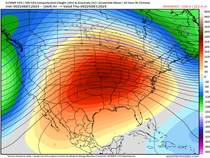SOME THOUGHTS ON WINTER...
- terryswails1
- Oct 6, 2020
- 4 min read
Since mid-August I've been hard at work putting together my coming book on this summer's devastating derecho. The project involves a great deal of research, writing, and photo acquisition and I'm working morning, noon, and night to reach my publishing deadline. It's so consuming that I looked at the calendar and realized man, winter's not that far away. In fact, last year it was snowing 3 weeks from now and not just a few flurries. Dubuque had its snowiest October on record with over 9 inches and Lowden in Cedar County had a foot according to the guru Steve Gottschalk. Most of my area had 5-8 times the monthly mean snowfall in two separate snow systems.

I was in Cedar Rapids back then and Halloween was white (Christmas was not). In terms of snowfall and snow depth was the snowiest Halloween in history, as it was in many other parts of the area.

While I have not finalized my winter outlook there are other sources that have and I will list them for you. What I see is a lot of variety in terms of severity and you can take your pick from mild to severe, dry to snowy. Let's start with the almanacs which always get a great deal of attention but in my opinion are not much to hang your hat on.
First the Farmers' Almanac. If you want a rip roaring winter this is your pick.

Below you can see The Old Farmer's Almanac is rather vague but basically about average, perhaps on the dry side.

Accuweather is a laugh, rain or snow...duh!

Then we get into the outlooks based on numerical models and we start with the EURO. It has no cold anywhere and if you aren't a fan of winter this is the warmest forecast I've seen.

The EURO is fairly wet and implies an active storm track but the mild air could mean more rain than snow.

The U.S. based CFSv2 shows near normal temperatures so no blow torch here like the EURO has.

The CFSv2 is also wet and I would think overall points towards above normal snowfall in my area.

The Canadian outlook is for slightly above normal temperatures but does point to a very active storm track with the Midwest the battleground for the warmth to the southeast and cold northwest.

It's precipitation pattern reflects that temperature fight with above normal precipitation throughout the Midwest and Ohio Valley. At face value I think this has the potential to produce some decent snows here were it to verify.

As I said, there is plenty of options to pick from and it shows the general uncertainty that exists with the type of winter the Midwest will experience. The three things I'm most interested in is the La Nina which will be in place, the sea surface temperatures that prevail, and the phases of the Madden Julien Oscillation.
La Nina's nationally generally favor cold across the north and warmth in the south. They often are good snow producers in the upper Midwest (Minnesota & Wisconsin) but are less snowy the further south you go.
Sea surface temperatures often dictate how blocking sets up and that establishes the position of the storm track. That also dictates the depth of cold air intrusions into the Midwest. Sea surface temperatures are important players.
Finally, the phase of the MJO is a crucial factor in locking in patterns for longer periods of time. We know that the cold phases of 8, 1, and 2 are best for harsh winter weather. We saw little of those phases last winter and that led to above normal temperatures most of December through early March.
Of the three factors I discussed, the one I would pick as the ultimate driver in a winter is the MJO as it's influenced by the others. If I knew what dominate phase the MJO would reside in I would have a much higher confidence in the overall strength of winter. I still need to monitor a few factors that remain in flux as they usually do going into October. That said, I am leaning toward a La Nina influenced winter that has the polar jet vacillating through the region. That should lead to some cold outbreaks but a couple of good thaws as well. On average I like a near to slightly below normal temperature pattern. As for precipitation, the position of the storm track is so critical and yet such a delicate feature to predict. A 150 mile shift north or south can have a huge influence on temperatures and precipitation type in a given region. That little shift can make or break a forecast. I think overall we are below normal on precipitation but near to slightly below normal on snowfall. Seasonal forecasting is really not my thing so take it with a grain of salt. This is little more than an educated guess.
Okay, time to get back to that book. Enjoy what will be a fine October day with sunshine and highs in the 70s! Roll weather...TS













Comments